The best areas of property to invest in right now
Questions continue to swirl around the state of the real estate market.
Will residential property prices continue to surge despite record breaking interest rate hikes?
Are office markets doomed if people continue working from home?
Why is online shopping growth flatlining?
In this wire, I'll explore what is happening in each of the property sectors and share some of Quay's investment ideas.
The challenges in commercial real estate sectors
Each of the traditional commercial real estate sectors, industrial, retail and office are facing different challenges at this interesting stage of the cycle.
Industrial
The industrial asset class has performed very well in recent memory. During COVID, many businesses advanced their online strategies to take advantage of lockdown-induced (artificially high) levels of demand. The lagged supply response has meant that for the past two to three years, there have been low vacancy rates, a highly competitive leasing environment, and record-breaking rental growth. Naturally, the sector has become very crowded, and from a valuation standpoint, the opportunities to buy the underlying real estate below replacement cost are few and far between.
The challenge for industrial will be to maintain the current leasing demand run rate in the face of a tempering business outlook and record levels of imminent supply delivery (especially in the US).
Over the long term, logistics real estate is tied to the performance of the tenants, who are fast approaching tougher conditions, led by a more cautious consumer.
In the US, the cracks are already
beginning to show. The employment growth in the warehousing sector has
historically been an accurate lead indicator for market rent growth in the US. As
cost pressures have forced companies to lay-off staff, we think it unlikely
that they will be well positioned for a significant increase in their monthly
rent expense.
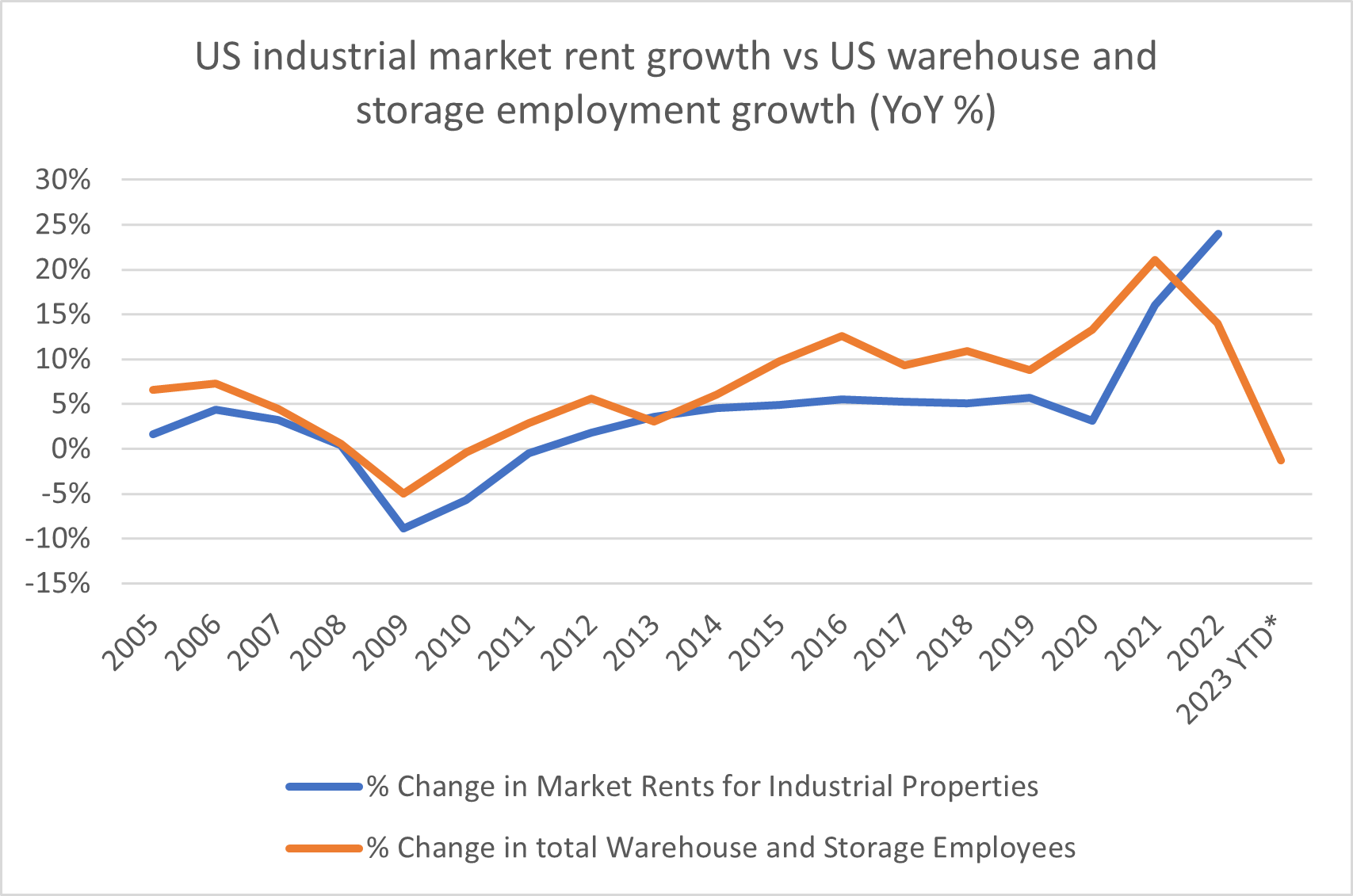
This is occurring while pockets of oversupply are emerging. For example, during Q2 2023, the Inland Empire Industrial market saw 3.6 million square feet of negative absorption (Colliers). The demand and supply imbalance is quickly reversing, with a risk that rental growth will begin to meaningfully decelerate.
Retail
Recent increases in interest rates have led to the fear of a ‘tightening of consumer belts’ due to cost of living pressures. Large regional shopping centres with a high number of non-discretionary specialty stores are the most exposed to this thematic. However, the resilience of best-in-class retail landlords’ cashflows is often overlooked, as evidenced by the through cycle performance of Scentre Group (ASX: SCG) below.
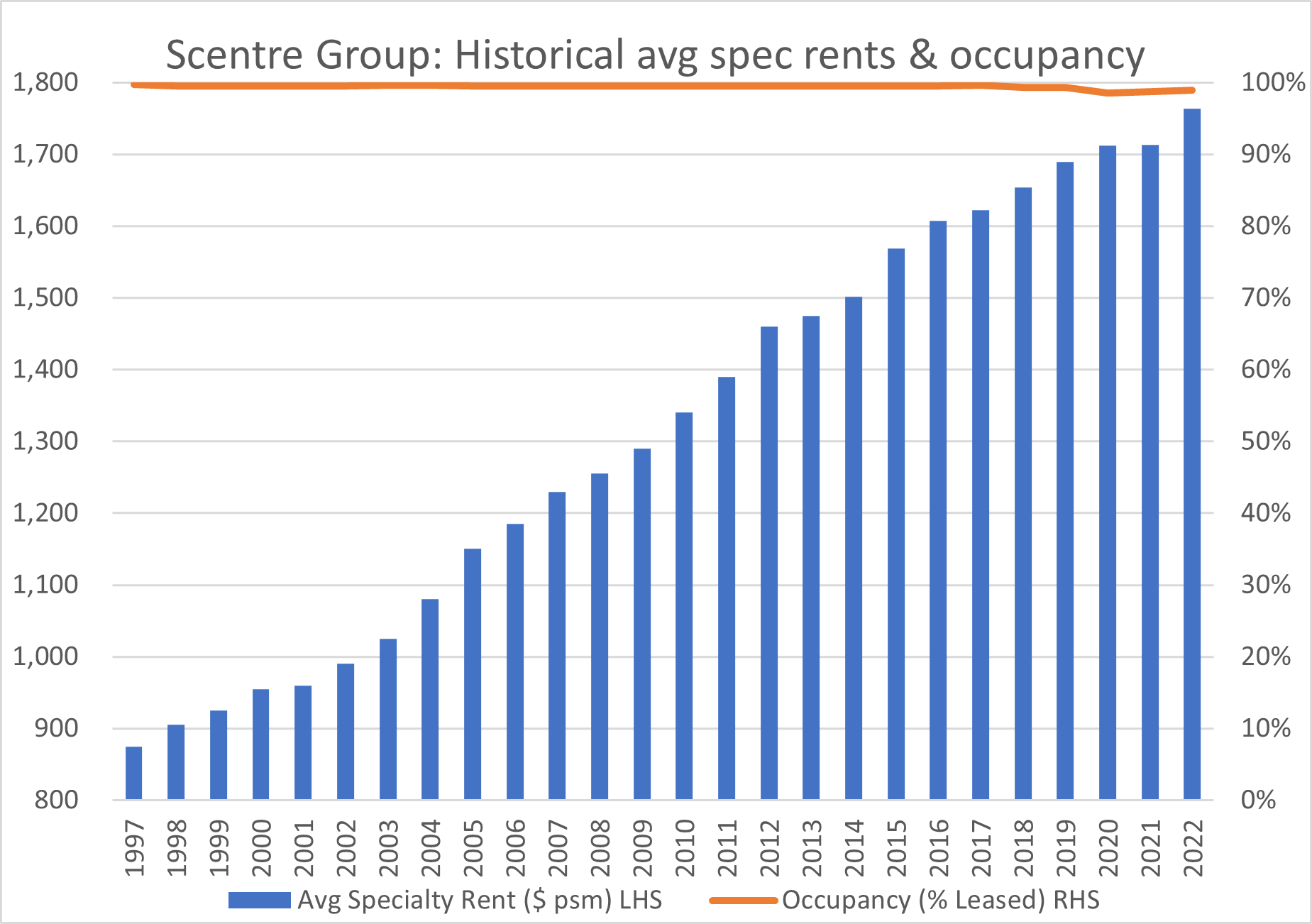
While past performance is no guarantee of future results, the good news is that brick and mortar retail sales have outstripped landlords’ ability to lift rent over the past few years. This has led to significant ‘under-renting’ across the top shopping centre REITs.
Even if sales growth falls to zero, we estimate rents can still lift by 10-15% over the next few years to ‘catch up’ with past sales.
The spike in online shopping following COVID lockdowns and generous government stimulus packages was inevitable. However, we believe the pure play online business model is under pressure amid rising customer acquisition costs, difficulty in satisfying price/timing expectations on deliveries, and struggles in building brand loyalty. This is reflected in the flatlining of online sales share of total retail sales in Australia.
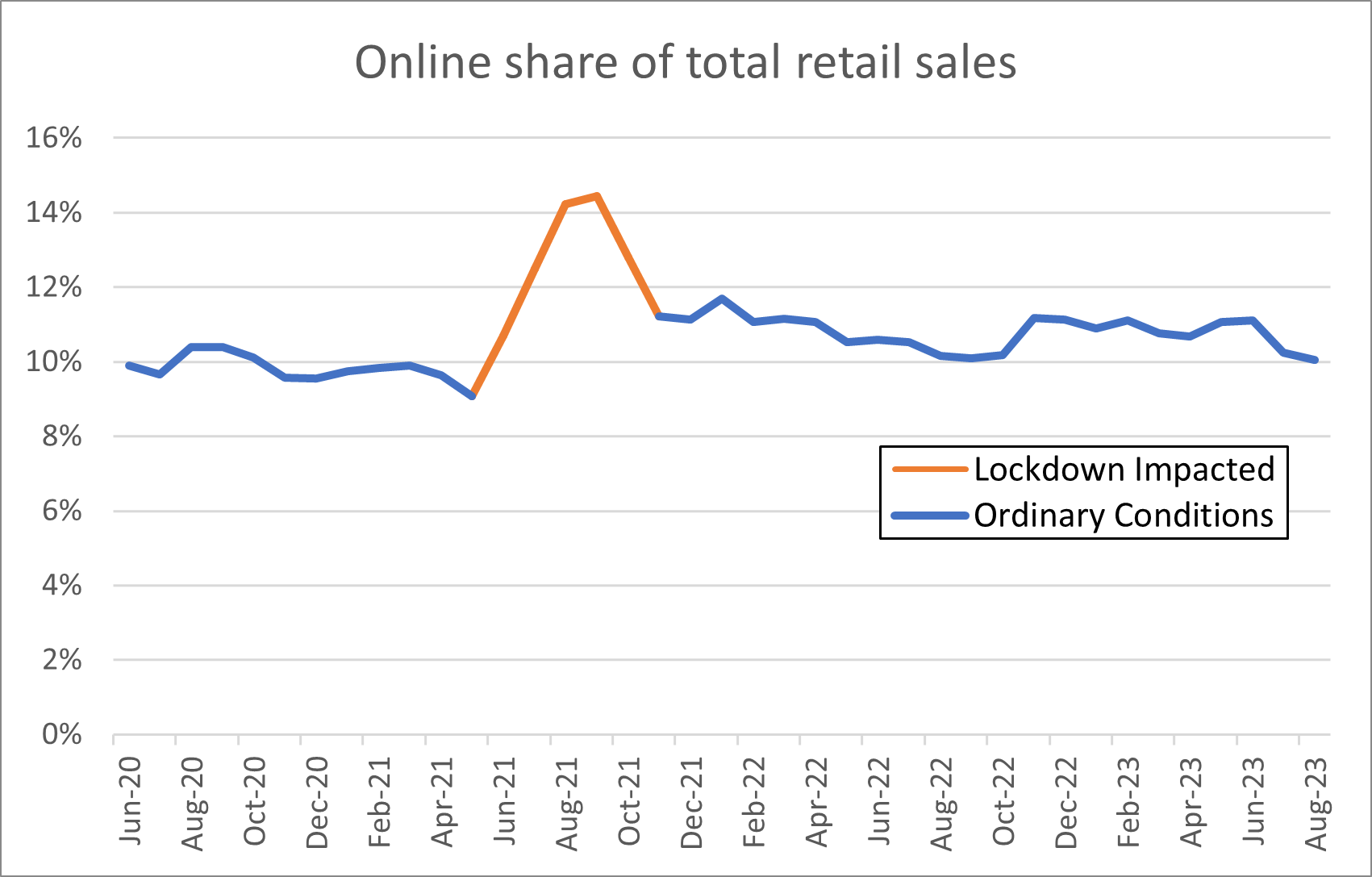
Source: ABS, Quay Global Investors
The current solution is the omni-channel strategy, with a focus on being highly selective in the brick and mortar stores that tenants select to represent their brand. We believe this will sustain leasing demand, rents and cashflow for the major retail landlords.
Office
The key challenge for office is the work from home dynamic. At face value, being in the office two days a week implies a 60% reduction in the need for office space, however in the absence of a highly efficient, highly restrictive rostering system (that prohibits staff from coming in on their designated ‘WFH day’), the ability for businesses to reduce their office space is limited.
Data from the major global office markets suggests Tuesday is now the new Monday, and Thursday is the new Friday, with most people having a strong preference to work from home closer to the weekend.
This has been reflected in the leasing results for top tier buildings in the
financial hubs of London and New York, which are trending toward to
pre-pandemic averages. These cities may prove to be strong lead indicators for
other financial based cities, such as Sydney. That said, there is a wave of new
supply on track to be delivered in the Sydney CBD and we are cautious that
today’s A class office buildings will be tomorrow’s B class.
Hard to be bearish on residential property
From the fixed rate mortgage cliff distress sales (that still haven’t happened), to the next pundit’s prediction that the Australian property bubble is about to burst, there is no shortage of bearish reading material this year. Putting the noise to the side, we believe the prospective return profile of the residential property market in Australia is strong because of an ongoing demand supply imbalance.
Most houses in Australia have commodity-like features, that is, are easily replaced when the development profit equation favours new supply. As such, we view the typical commodity property cycle through the below framework.

This current problem is the development equation generally doesn’t work. The cost of developing residential property in Australia is high by global standards. This is largely due to significant government-related taxes and charges, tight regulations, skilled labour shortages and persistent building material inflation.
Since 2001, the cost of developing a new house in Australia has increased 6.1% per annum, accelerating to 8% p.a. since June 2019.
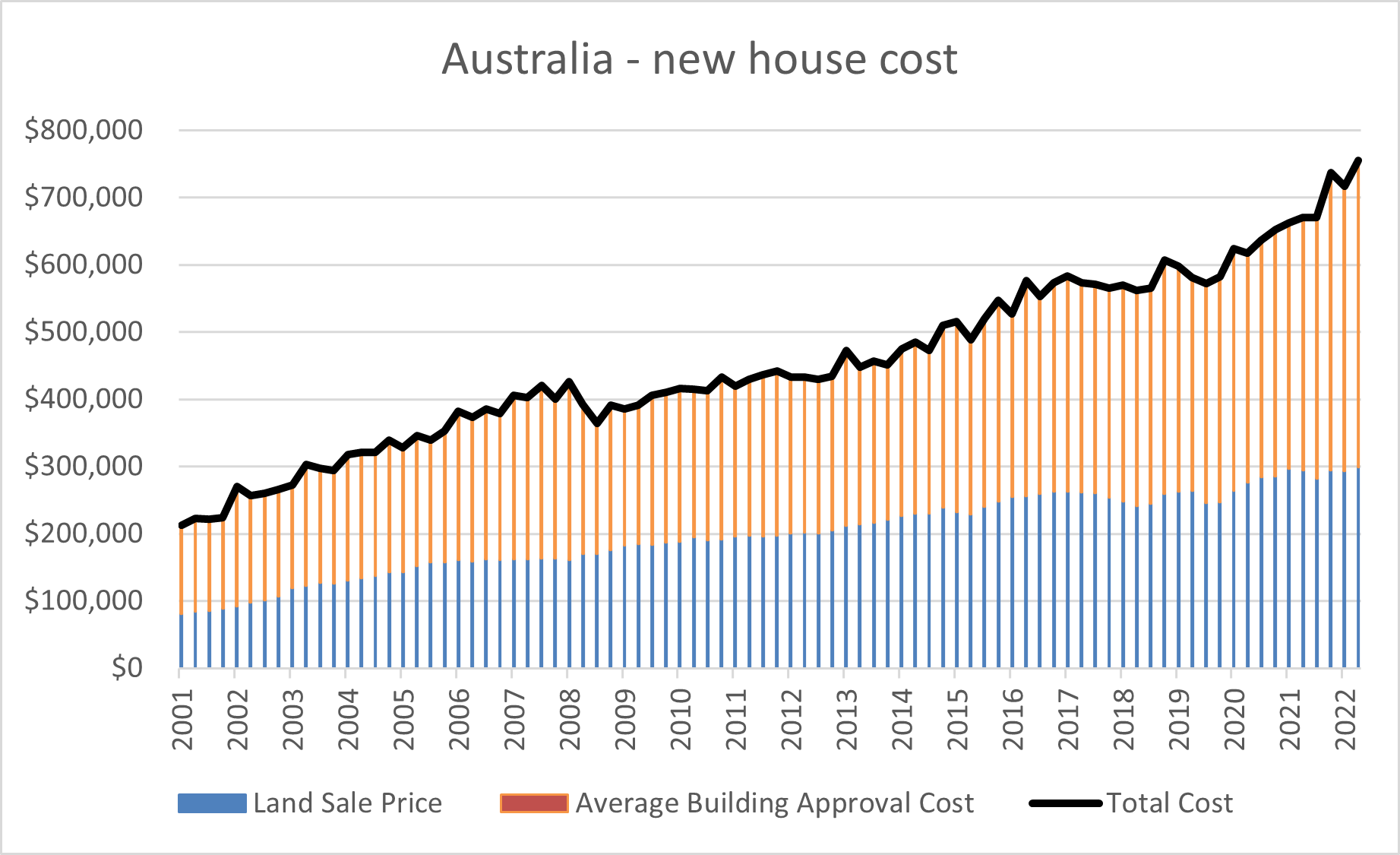
Source: Jarden, ABS, HIA, Quay Global Investors
The RBA’s recent rate hiking regimen has only added fuel to this fire, with the cost of funding blowing previously plausible feasibilities out of the water. In short, the decisions by the RBA (and other central banks around the world), are putting a halt on new supply, just at a time when Australia needs it most.
The Australian housing ‘crisis’ will not be solved until the cost of supplying the market is lowered, or dwelling prices rise above replacement cost (very high).
The challenges with supplying the housing market are evidenced in the sustained drop in new supply, now down 45% from the 2021 peak.

This constrained supply has been met with robust demand, which is being evidenced in both the ownership and rental residential markets. In the for-sale market, house prices have risen 4.9% since February (Core Logic), and in the rental market we have seen a sustained drop in the vacancy rate and strong rental growth (below).
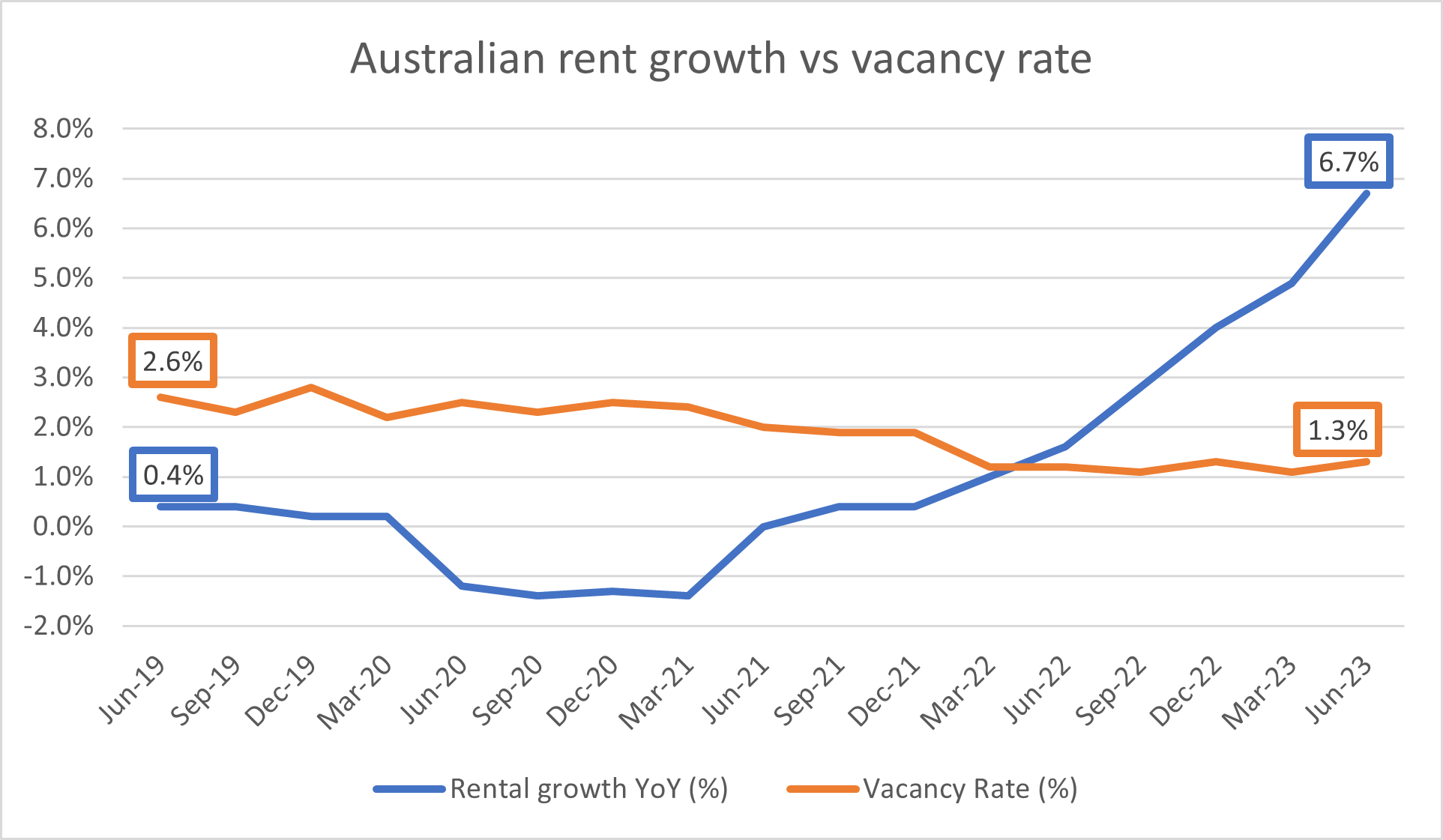
Put simply, until developers are financially incentivised to build again, these conditions will remain, and likely gain momentum. For long-term investors, it's hard to be bearish Australian residential right now.
Where should investors look at this stage of the cycle?
Listed real estate has de-rated significantly over the past 12-18 months, which has increased the attractiveness of a range of opportunities in the global real estate market.
Looking at the spread of earnings multiples between global real estate and global equities, we can see that the relative pricing for the sector is very attractive. This broad sell-off has been driven by macroeconomic volatility in bond markets. However, as we have (hopefully) learnt from the Australian residential experience, high interest rates do not always lead to falling property prices.
Ultimately, supply and demand matter. Based on company feedback and published macro-economic data, there is little sign there will be any new supply to the property in the medium term. As a result, we believe there is an emerging rental squeeze across most real estate asset classes over the next few years.

Source: Factset, Bloomberg, Quay Global Investors
With this in mind, it’s worth remembering that long-term real estate security prices follow earnings that in turn are driven by rents and cashflow.
The property types that we believe are best positioned to benefit from near-term rental growth via the demand/supply imbalance are US single-family residential and senior housing REITs.
The US housing market draws many parallels to the demand/supply imbalance that is occurring in Australia. One key characteristic of the US market is that home inventory levels have normalised at circa 50% below long-term averages, with homeowners being locked into their low rate, fixed 30-year mortgages (refinance rate 7.75%).
This has pushed housing unaffordability to record heights, and with a wave of Millennials aging into their prime single family living years, we expect participation in the rental market to accelerate substantially.
Senior housing performed poorly during the pandemic, with new complexities being added to virtually every aspect of the business. This resulted in occupancy levels falling 10-20% across healthcare REITs in the US and Canada. With COVID in the rear view mirror (hopefully), and a rapidly aging population, we are beginning to see a sustained recovery in occupancy rates. This is having an outsized impact on earnings and cashflow growth due to the operating leverage in these overseas REIT structures.
This article was written by Chris Bedingfield and Nick Stack.
Invest in global listed real estate
Quay Global Investors, a Bennelong Funds Management boutique, focuses on the preservation and creation of wealth through innovative strategies in real estate securities. For more insights on global property, visit Quay’s website.

2 topics
1 stock mentioned
1 fund mentioned

